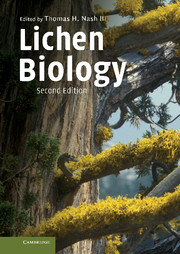Book contents
- Frontmatter
- Contents
- List of contributors
- Preface
- 1 Introduction
- 2 Photobionts
- 3 Mycobionts
- 4 Thallus morphology and anatomy
- 5 Morphogenesis
- 6 Sexual reproduction in lichen-forming ascomycetes
- 7 Biochemistry and secondary metabolites
- 8 Stress physiology and the symbiosis
- 9 Physiological ecology of carbon dioxide exchange
- 10 The carbon economy of lichens
- 11 Nitrogen, its metabolism and potential contribution to ecosystems
- 12 Nutrients, elemental accumulation, and mineral cycling
- 13 Individuals and populations of lichens
- 14 Environmental role of lichens
- 15 Lichen sensitivity to air pollution
- 16 Lichen biogeography
- 17 Systematics of lichenized fungi
- Appendix: Culture methods for lichens and lichen symbionts
- References
- Taxon index
- Subject index
9 - Physiological ecology of carbon dioxide exchange
Published online by Cambridge University Press: 05 September 2012
- Frontmatter
- Contents
- List of contributors
- Preface
- 1 Introduction
- 2 Photobionts
- 3 Mycobionts
- 4 Thallus morphology and anatomy
- 5 Morphogenesis
- 6 Sexual reproduction in lichen-forming ascomycetes
- 7 Biochemistry and secondary metabolites
- 8 Stress physiology and the symbiosis
- 9 Physiological ecology of carbon dioxide exchange
- 10 The carbon economy of lichens
- 11 Nitrogen, its metabolism and potential contribution to ecosystems
- 12 Nutrients, elemental accumulation, and mineral cycling
- 13 Individuals and populations of lichens
- 14 Environmental role of lichens
- 15 Lichen sensitivity to air pollution
- 16 Lichen biogeography
- 17 Systematics of lichenized fungi
- Appendix: Culture methods for lichens and lichen symbionts
- References
- Taxon index
- Subject index
Summary
Photosynthesis is used by autotrophic organisms to convert light energy into chemical energy for maintenance, growth, and reproduction. Heterotrophs have shown considerable agility in forming symbiotic relationships with autotrophs so that they obtain a reliable carbon source. The endosymbiont theory proposes that the chloroplast of eukaryotic cells evolved from photosynthetic cyanobacterium-like organisms which were engulfed by nonphotosynthetic cells, leading eventually to the evolution of algae and plants. Fungi have also developed symbioses, one being the lichen, an extrasymbiosis with photosynthetic algae and/or cyanobacteria, which, in many respects, appears to function like a single autotrophic “organism.” Its photosynthesis and respiration are complex biophysical and biochemical processes that will not be discussed here in any detail. We shall restrict our analysis to those aspects that are of ecological relevance, in particular carbon dioxide (CO2) exchange, which is the subject of this chapter.
On average, approximately 40 to 50% of a lichen's dry mass consists of carbon which is almost exclusively fixed by photobiont photosynthesis. Photosynthetic processes are vital for the existence, survival, and growth of the lichen. Energy-producing respiratory processes that release CO2 occur in both the mycobiont and photobiont, although the individual contributions of the symbionts to the respiration of the whole lichen thallus are not yet known. However, it is most probable that total thallus respiration mainly reflects the metabolic activity of the fungal partner (Quispel 1960).
- Type
- Chapter
- Information
- Lichen Biology , pp. 152 - 181Publisher: Cambridge University PressPrint publication year: 2008
- 46
- Cited by

